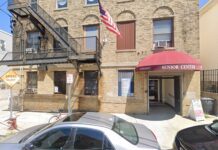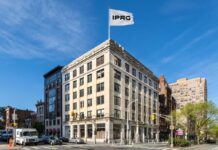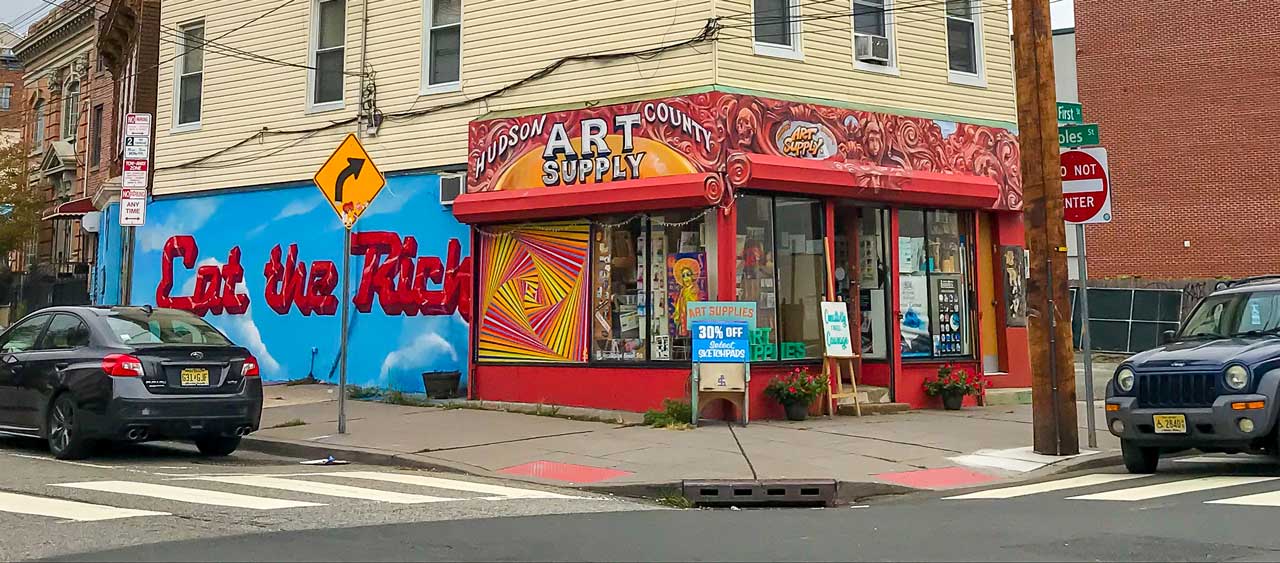
Given the magnitude of Jersey City’s building boom, few undeveloped lots in Downtown Jersey City remain. For developers, these sites — potential locations for new luxury condominiums, stylish shops, and chic restaurants — are desirable commodities. As with any gentrifying city, someone has to make room for new development. Such is the case for John McInerney, owner of Hudson County Art Supply, who leases the commercial retail space at 303 1st Street.
Situated at the intersection of Coles and 1st Streets, just beyond the newly expanded Newark Avenue Pedestrian Plaza, Hudson County Art Supply has been a fixture at the edge of the Village neighborhood since 2003. After 15 years in Downtown Jersey City, Hudson County Art Supply, distinguished by its vibrant outdoor mural gallery, will relocate to 469 Central Avenue in Jersey City Heights during the first week of October 2018.
On the surface, a longtime business relocating within a city is unremarkable news. Some businesses such as A&S Convenience and Smoke Shop — once located on Marin Boulevard and now the Paulus Hook Vape Shop on Washington Boulevard — closed with little attention before the building was torn down to make way for 331 Marin Boulevard.
Hudson County Art Supply’s move is even less remarkable considering that the store has previously operated out of locations in Hoboken and at Mana Contemporary. Yet 303 1st Street, the three-story residential building where Hudson County Art Supply currently leases the ground-floor commercial space, is tied up in a legal dispute with real estate developer Peter Mocco.
The Jersey Journal, reporting in June, outlines the failed negotiation of sale between Mocco and Roberto Cruz Sr., who is McInerney’s landlord. In June, both Cruz and Mocco filed complaints against each other. 303 1st Street is located next to three Mocco-owned properties. Once Mocco completes the purchase of 303 1st Street, the building will be demolished and construction will begin on a five-story apartment complex.
McInerney is caught up in the dispute, but he understands the complexities of Jersey City’s resurgence. Prior to leasing 303 1st Street, McInerney owned residential buildings and flipped a few properties in Downtown Jersey City, allowing him to open his business. “That was how I stayed afloat,” he says, explaining that owning property in Jersey City is “a learning curve.”
Hudson County Art Supply opened in the Village neighborhood — historically an Italian-American enclave consisting of low-rise, multi-family homes — in 2003. “The reason I opened my store,” McInerney explains, “was economic opportunity. There were no stores here. That’s because the area was boarded up.” Affordable rent has allowed Hudson County Art Supply to operate out of the same location for over a decade. For a small business directly impacted by online competitors — McInerney admits he often forgoes a salary — Hudson County Art Supply’s longevity in the community is a noteworthy feat.
The store — a small space — is well stocked with nearly every art supply imaginable, ranging from high-end brushes to trendy adult coloring books. Hudson County Art Supply caters to artists, students, and anyone just wanting to stop in for a chat. Even in its final days at the Downtown location, foot traffic is consistent throughout business hours. Employee Carlos Castillo mans the store most days. But on Sundays, it’s McInerney who can be found answering the phone with a resounding “Art Supply,” before he helps harried customers check for items in stock.
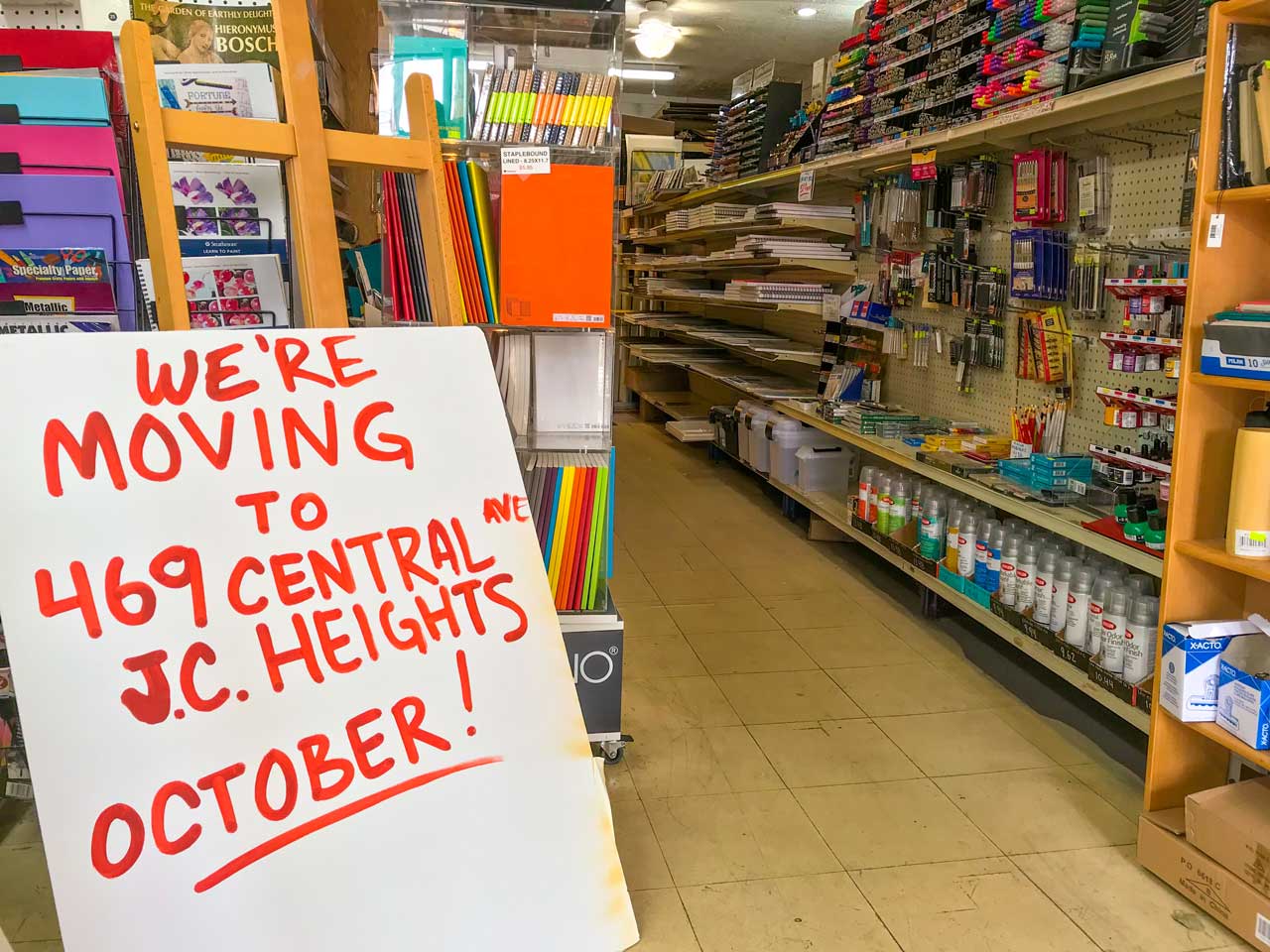
Development and gentrification is a gradual process for any city, either aided by or tied up in the planning, zoning, and tax regulations. In Downtown Jersey City, gentrification often becomes encapsulated by the stories of two places: the Golden Cicada and 111 1st Street. The Golden Cicada has been romanticized as a story of resistance, but 111 1st Street is a story of loss.
Ostensibly, the stories of these businesses and communities are not linked by anything other than shared time and place. (Hudson County Art Supply opened just as the last artists at 111 1st Street were being pushed out. McInerney, in our interview, admitted, “I’m not part of that story as much as you would think.”) But 111 1st Street’s legacy of lost potential and displacement still resonates within Jersey City.
Like the 111 artists who left Downtown Jersey City for elsewhere — some within Jersey City but many to new communities — small businesses like Hudson County Art Supply must choose to relocate or close altogether. As new luxury high-rises continue to pepper the Downtown Jersey City skyline, the local spots that create the fabric of the city — bars, convenience stores, delis, laundromats, dry cleaners, art studios — disappear with little fanfare.
Hudson County Art Supply is just the latest business disappearing from the Village neighborhood’s commercial stretch in the vicinity of Newark Avenue between Coles and Brunswick Streets. Jordan’s Lounge, a popular bar and nightclub, was demolished to make way for 245 Newark Avenue. 270 Newark Avenue, a 150-year-old historic building and most recently the site of the Golden Grille, was demolished in 2018. The project’s developer hopes to flip the site. Both Newark Avenue projects signal an uptick in development proposals encroaching on neighborhoods just outside of the Historic Downtown Jersey City.
When reflecting on how the neighborhood has changed in the last two decades, McInerney observes, “It’s not Chilltown anymore,” referencing Jersey City’s popular moniker.
“I walked around here when I first moved here,” he explains, “and it felt like a small town.” At the time, McInerney lived downtown; he has since moved to the Marion neighborhood near Journal square. “I loved the diversity. Now there’s still diversity but it’s not like it was. It’s not just different people. It’s a different economical standing.” McInerney believes that Jersey City’s change is the result of economics and development. “If you increase the taxes on all the residents and give tax abatements to the developers,” he explains, “all you have left is developers.”
Ironically, 303 1st Street’s location near the Newark Pedestrian Plaza has benefitted Hudson County Art Supply. “I’d stay if I could. I had my best year ever because it’s so dense here now. I’m getting more business because there’s more people,” McInerney says. Still, McInerney looks forward to the new Central Avenue location. The Central Avenue Special Improvement District has been integral in helping with the store’s relocation. After receiving positive feedback when he announced the store’s move on Facebook, McInerney believes, “I think we’re gonna find a community up there.”
But Hudson County Art Supply is not leaving Downtown Jersey City quietly. In mid-September, local artists Sam Pullin and DISTORT painted “Eat the Rich,” in bold red, block lettering on the building’s mural wall. The Coles Street mural wall is a place where artists can paint freely, without municipal oversight, a hindrance of collaborating with the Jersey City Mural Arts Program. McInerney guesses that more than 100 murals by mostly local artists have been featured on the wall since 2009. “It’s just a way for the artists to have a voice,” says McInerney.
“Basically anybody who’s done art on that main wall has been people we’ve known for years. It’s a trusted wall,” explains Carlos Castillo, who oversees the murals. “We let [the artists] do whatever they want to do. No creative restraints. Pullin reached out about creating the final mural and the end result is a poetic message.
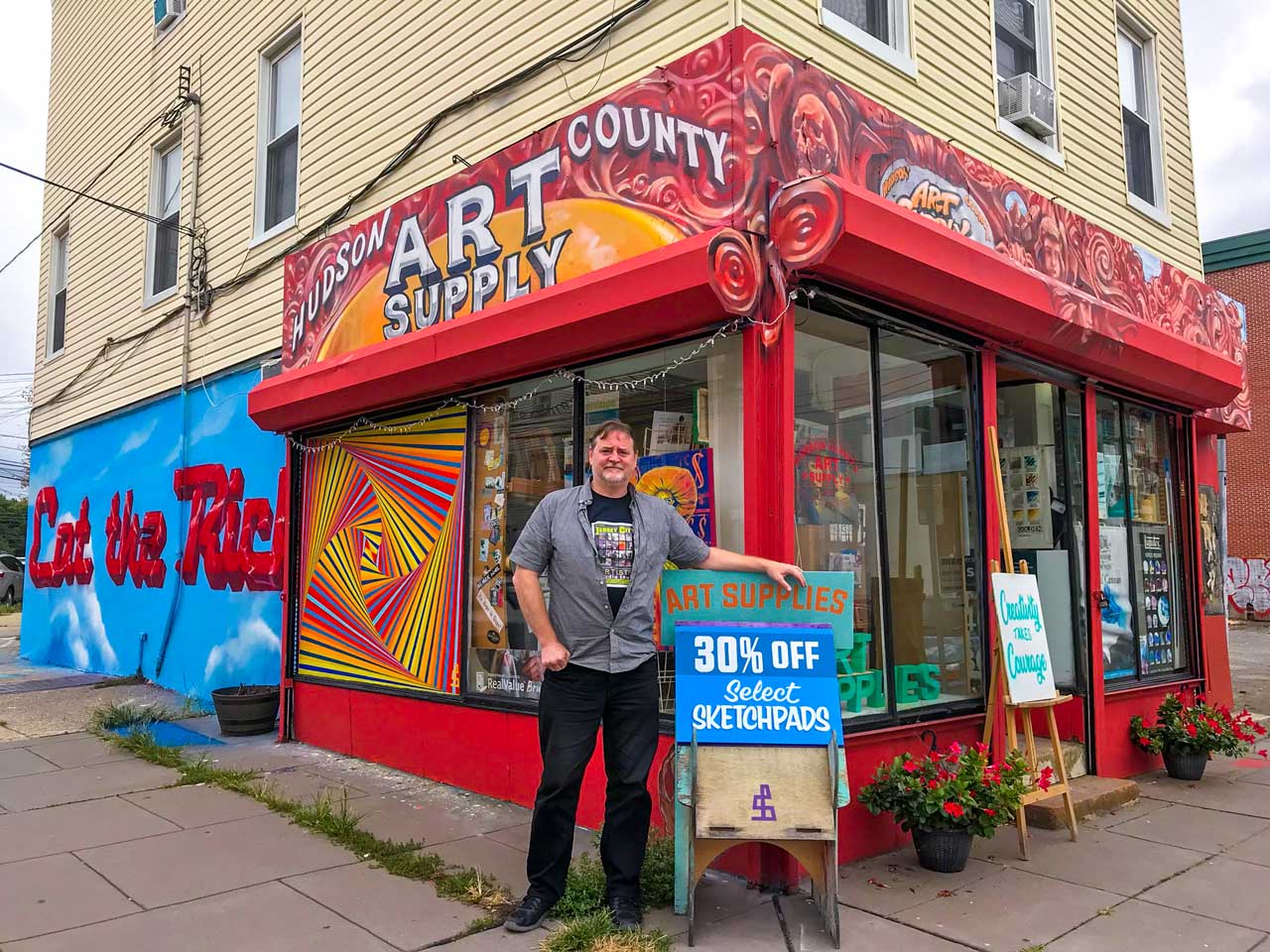
“We felt like it was a good way to go,” says Castillo. “It goes with what’s happening with this place. We’re not really priced out. The building is coming down and there’s nothing we can do to stop it from happening.”
Hudson County Art Supply will be located at 469 Central Avenue in Jersey City Heights beginning in October 2018.
